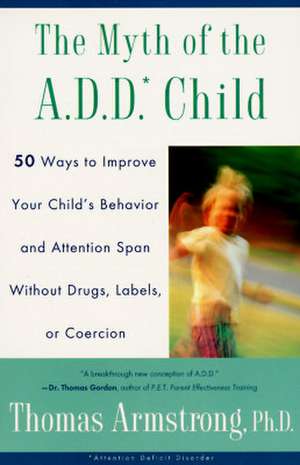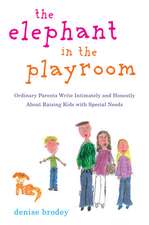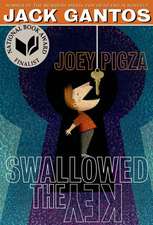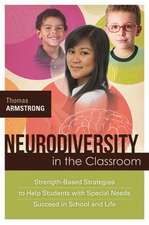The Myth of the A.D.D. Child: 50 Ways Improve Your Child's Behavior Attn Span W/O Drugs Labels or Coercion
Autor Thomas Armstrongen Limba Engleză Paperback – 31 aug 1997 – vârsta de la 18 ani
In this controversial and provocative book, Dr. Thomas Armstrong confronts America?s obsession with Attention Deficit Disorder. With more than one million children diagnosed with ADD, the condition has gained national attention on talk shows, magazine covers and The New York Times bestseller list. Dr. Armstrong, well-known for his writings on parenting and education, presents the very real argument that ADD may, in fact, not exist. He believes that many behaviors labeled as ADD are simply a child?s active response to complex social, emotional, and educational influences, and that by tackling the root causes of a child?s attention and behavior problems?rather than masking the symptoms with medication and behavior-modification programs?parents can help their children begin to experience fundamentally positive changes in their lives. This groundbreaking book provides parents and professionals with 50 innovative and proven strategies they can use to help children overcome their attention and behavior problems. His checklist helps parents decide which strategies are most appropriate, and hundreds of resources, including books and organizations are included. The Myth of the A.D.D. Child offers much needed practical help to both parents and professionals.
Preț: 137.94 lei
Nou
Puncte Express: 207
Preț estimativ în valută:
26.40€ • 28.66$ • 22.17£
26.40€ • 28.66$ • 22.17£
Carte disponibilă
Livrare economică 01-15 aprilie
Preluare comenzi: 021 569.72.76
Specificații
ISBN-13: 9780452275478
ISBN-10: 0452275474
Pagini: 336
Dimensiuni: 153 x 229 x 22 mm
Greutate: 0.36 kg
Editura: Plume Books
ISBN-10: 0452275474
Pagini: 336
Dimensiuni: 153 x 229 x 22 mm
Greutate: 0.36 kg
Editura: Plume Books
Cuprins
Preface to the Paperback Edition
Preface
Part One. Uncovering the A.D.D. Myth
Chapter 1: America's New Learning Disease
Chapter 2. A.D.D.: Now You See It, Now You Don't
Chapter 3. Why A.D.D. Is a Simplistic Answer to the Problems of a Complex World
Chapter 4. What's Good (and Not So Good) About the Good Pill
Chapter 5. To Control or to Empower: That Is the Question!
Part Two. 50 Strategies to Improve Your Child's Behavior and Attention Span
Introduction
#1 Provide a Balanced Breakfast
#2 Consider the Feingold Diet
#3 Limit Television and Video Games
#4 Teach Self-Talk Skills
#5 Find Out What Interests Your Child
#6 Promote a Strong Physical Education Program in Your Child's School
#7 Enroll Your Child in a Martial Arts Class
#8 Discover Your Child's Personal Learning Style
#9 Use Background Music to Focus and Calm
#10 Use Color to Highlight Information
#11 Teach Your Child to Visualize
#12 Remove Allergens from the Diet
#13 Provide Opportunities for Physical Movement
#14 Enhance Your Child's Self-Esteem
#15 Find Your Child's Best Times of Alertness
#16 Give Instructions in Attention-Grabbing Ways
#17 Provide a Variety of Stimulating Learning Activities
#18 Consider Biofeedback Training
#19 Activate Positive Career Aspirations
#20 Teach Your Child Physical-Relaxation Techniques
#21 Use Incidental Teaching to Teach
#22 Support Full Inclusion of Your Child in a Regular Classroom
#23 Provide Positive Role Models
#24 Consider Alternative Schooling Options
#25 Channel Creative Energy into the Arts
#26 Provide Hands-On Activities
#27 Spend Positive Times Together
#28 Provide Appropriate Spaces for Learning
#29 Consider Individual Psychotherapy
#30 Use Touch to Soothe and Calm
#31 Help Your Child with Organizational Skills
#32 Help Your Child Appreciate the Value of Personal Effort
#33 Take Care of Yourself
#34 Teach Your Child Focusing Techniques
#35 Provide Immediate Feedback
#36 Provide Your Child with Access to a Computer
#37 Consider Family Therapy
#38 Teach Problem-Solving Skills
#39 Offer Your Child Real-Life Tasks to Do
#40 Use "Time Out" in a Positive Way
#41 Help Your Child Develop Social Skills
#42 Contract with Your Child
#43 Use Effective Communication Skills
#44 Give Your Child Choices
#45 Discover and Treat the Four Types of Misbehavior
#46 Establish Consistent Rules, Routines, and Transitions
#47 Hold Family Meetings
#48 Have Your Child Teach a Younger Child
#49 Use Natural and Logical Consequences
#50 Hold a Positive Image of Your Child
Notes
Index
Preface
Part One. Uncovering the A.D.D. Myth
Chapter 1: America's New Learning Disease
Chapter 2. A.D.D.: Now You See It, Now You Don't
Chapter 3. Why A.D.D. Is a Simplistic Answer to the Problems of a Complex World
Chapter 4. What's Good (and Not So Good) About the Good Pill
Chapter 5. To Control or to Empower: That Is the Question!
Part Two. 50 Strategies to Improve Your Child's Behavior and Attention Span
Introduction
#1 Provide a Balanced Breakfast
#2 Consider the Feingold Diet
#3 Limit Television and Video Games
#4 Teach Self-Talk Skills
#5 Find Out What Interests Your Child
#6 Promote a Strong Physical Education Program in Your Child's School
#7 Enroll Your Child in a Martial Arts Class
#8 Discover Your Child's Personal Learning Style
#9 Use Background Music to Focus and Calm
#10 Use Color to Highlight Information
#11 Teach Your Child to Visualize
#12 Remove Allergens from the Diet
#13 Provide Opportunities for Physical Movement
#14 Enhance Your Child's Self-Esteem
#15 Find Your Child's Best Times of Alertness
#16 Give Instructions in Attention-Grabbing Ways
#17 Provide a Variety of Stimulating Learning Activities
#18 Consider Biofeedback Training
#19 Activate Positive Career Aspirations
#20 Teach Your Child Physical-Relaxation Techniques
#21 Use Incidental Teaching to Teach
#22 Support Full Inclusion of Your Child in a Regular Classroom
#23 Provide Positive Role Models
#24 Consider Alternative Schooling Options
#25 Channel Creative Energy into the Arts
#26 Provide Hands-On Activities
#27 Spend Positive Times Together
#28 Provide Appropriate Spaces for Learning
#29 Consider Individual Psychotherapy
#30 Use Touch to Soothe and Calm
#31 Help Your Child with Organizational Skills
#32 Help Your Child Appreciate the Value of Personal Effort
#33 Take Care of Yourself
#34 Teach Your Child Focusing Techniques
#35 Provide Immediate Feedback
#36 Provide Your Child with Access to a Computer
#37 Consider Family Therapy
#38 Teach Problem-Solving Skills
#39 Offer Your Child Real-Life Tasks to Do
#40 Use "Time Out" in a Positive Way
#41 Help Your Child Develop Social Skills
#42 Contract with Your Child
#43 Use Effective Communication Skills
#44 Give Your Child Choices
#45 Discover and Treat the Four Types of Misbehavior
#46 Establish Consistent Rules, Routines, and Transitions
#47 Hold Family Meetings
#48 Have Your Child Teach a Younger Child
#49 Use Natural and Logical Consequences
#50 Hold a Positive Image of Your Child
Notes
Index
Notă biografică
Thomas Armstrong, Ph.D., is a psychologist, learning specialist, and consultant to educational groups around the world. He has written for Family Circle, Ladies' Home Journal, and Parenting magazine, and is the author of nine books, including Awakening Your Child's Natural Genius and The Myth of the A.D.D. Child.
Descriere
With more than one million children diagnosed with ADD, the condition has become an obsession. Here parenting expert Thomas Armstrong provides parents and professionals with 50 groundbreaking and proven strategies they can use to help children overcome attention and behavior problems.









